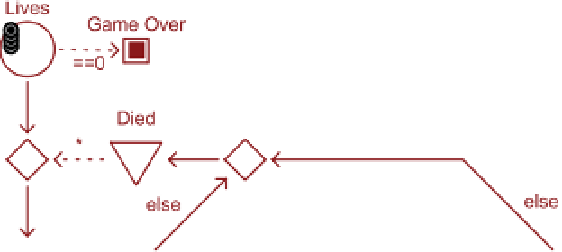Game Development Reference
In-Depth Information
Power-Ups and Collectibles in Action Games
The gameplay of action games emerges primarily from interesting physics and good
player interaction. The levels of many action games are fairly linear: The player
simply needs to perform a number of tasks, each with a certain chance to fail. His
objective is to reach the end of a level before running out of lives.
Figure 6.33
represents a small level for an action game with three tasks (A, B, and C). Each is
represented by a skill gate that generates a number between 1 and 100. The player
is represented by a resource that moves from pool to pool. If the player fails to per-
form a task, there are two options: Either he dies (as is the case with tasks A and C)
or he is sent back to a previous location in the level (as is the case with task B).
FIGURe 6.33
Level progression in an
action game
Most action games are more than just a series of tasks, however. They usually have
an internal economy that revolves around power-ups and collectible items. For
example, in
Super Mario Bros.
,
the player can collect coins to gain extra points and
lives, while power-ups grant the player special powers, some of which have a limited
duration. Power-ups and collectibles can be represented in Machinations diagrams
by resources that are harvested from certain locations.
Figure 6.34
shows how this
might be modeled using different colored resources to indicate different power-ups
or collectibles. In this diagram, the player must be present at a certain location to
be able to collect the power-up. This diagram also shows how power-ups and col-
lectibles can be used to offer players different strategic options. In this case, the
player can progress through the level quickly and fairly easily if she goes from loca-
tion I to II and V immediately. However, she can also opt for the more dangerous
route through III and IV, in which case she can collect one red and two extra yellow
resources.












